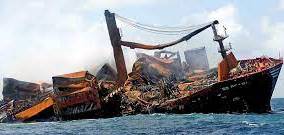
Let's remember. Almost 7 months ago, we reported on the worst environmental disaster Sri Lanka has ever experienced . The X-Press Pearl ship ran aground not far from the coast of the country, releasing a multitude of toxic products into the waters. A major ecological disaster ensued. Reminder of the facts and where we are today.
It is visible in satellite images off the coast of Sri Lanka: a thin gray film that meanders three kilometers out to sea before disappearing into the waves.
Marker buoys were deployed around the outskirts of X-Press Pearl to create a 50 meter safety zone around the wreck.
The web is a visceral reminder of what observers say is an environmental disaster in slow motion - one of the worst in the country's history - and the enormous effort that will be needed to clean it.
"This is the biggest environmental disaster to hit Sri Lanka since the 2004 Indian Ocean tsunami," said Thummarukudyil Muraleedharan, operations director of the United Nations Program's Crisis Management Directorate. United for the Environment (UNEP).
Thummarukudyil is one of more than half a dozen UNEP experts advising the Sri Lankan government on how to contain the toxic fallout from the sinking of the X-Press Pearl, which was carrying 81 containers of hazardous materials when it sank in June, according to her owner, X-Press Feeders. The ship's cargo included 25 tonnes of nitric acid, 348 tonnes of oil and, according to independent estimates, up to 75 billion small plastic known as nurdles of which created a historic oil spill; a crisis that could afflict Sri Lanka for years.
"It's a toxic vessel," said Hemantha Withanage, executive director of the Sri Lanka Center for Environmental Justice, an advocacy group. “It will be a long-standing disaster. »
Crew members first noticed smoke coming from the hold of the X-Press Pearl on May 20, while the ship was anchored off Colombo, the capital of Sri Lanka. Over the next two weeks, fire crews battled a raging inferno punctuated by at least two major explosions. As the ship slowly sank – it wouldn't be until June 17 before it touched the seabed – strong currents picked up shipping containers and strewn them along the Sri Lankan coast.
A container surfaced more than 100 kilometers south of the wreckage, blanketing major tourist beaches near the southwestern resort town of Galle with nurdles.
“It was like a ticking time bomb ,” said Hassan Partow, program manager in UNEP's Post-Conflict and Disaster Management Branch.
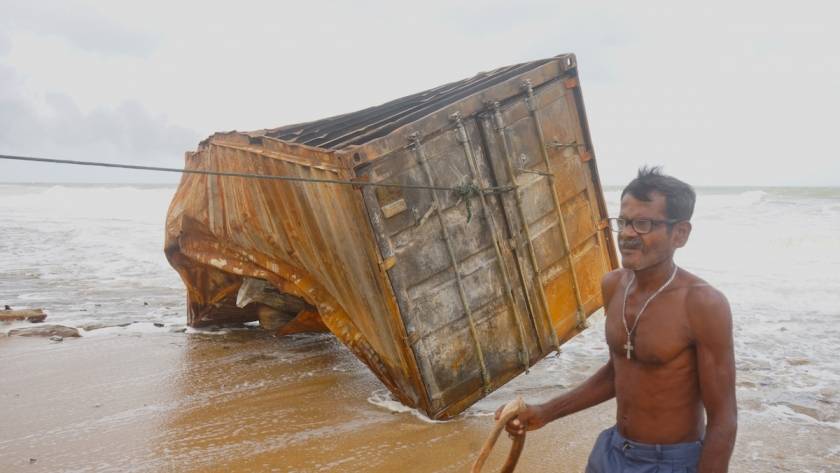 A shipping container charred, one of more than 1400 in the X-Press Pearl, is drawn from a beach west of Sri Lanka. The containers surfaced up to 100 km from where the ship sank. Photo: Sri Lanka Marine Environment Protection Authority
A shipping container charred, one of more than 1400 in the X-Press Pearl, is drawn from a beach west of Sri Lanka. The containers surfaced up to 100 km from where the ship sank. Photo: Sri Lanka Marine Environment Protection Authority
Plastic pollution
For Sri Lankan, small plastic pellets, which are about the size of a lens, have been the most visible signs of the sinking of the bead X-Press.
Using publicly available data, Withanage estimates that the vessel contained 70 to 75 billion individual pellets. Partow said the disaster is the largest release of nurdles into the ocean ever reported.
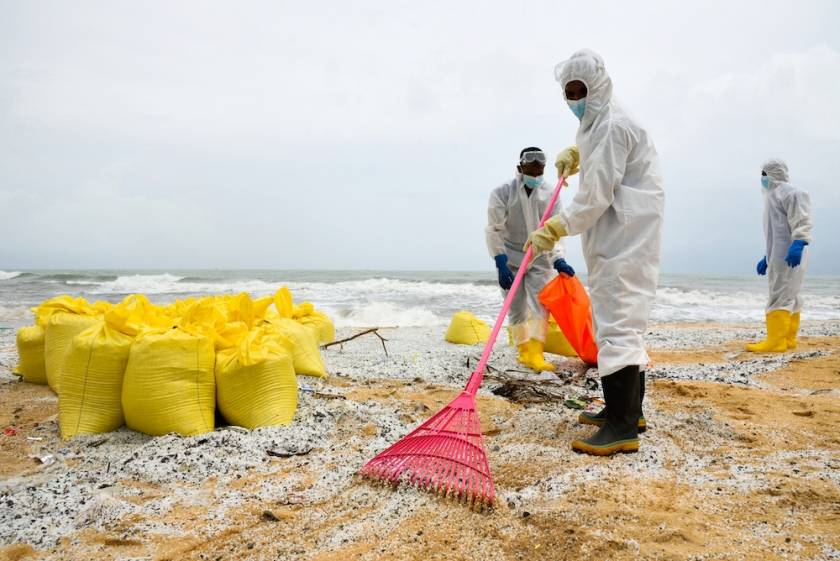 Teams collect plastic granules of the size of a lentil on a beach Sri Lanka. By one estimate, the X-Press Pearl was carrying some 75 billion of these pellets when it sank off the coast of Colombo. Photo: Shutterstock/Ruwan Walpola
Teams collect plastic granules of the size of a lentil on a beach Sri Lanka. By one estimate, the X-Press Pearl was carrying some 75 billion of these pellets when it sank off the coast of Colombo. Photo: Shutterstock/Ruwan Walpola
Plastic has flooded the beaches around Colombo. One of them, Sarukkuwa, was covered with piles of plastic one meter high. Nurdles have also appeared in the gills and entrails of fish. Local fishermen, who have been shut out of the abundant fishing grounds around Colombo, have blamed the nurdles for killing marine life, although this claim is still being investigated by Sri Lankan scientists. Withanage said pellets were also found at a turtle sanctuary 300 km north of Colombo.
Over time, the pellets, which will take up to 1,000 years to disintegrate, could build up in the food chain, sickening fish and potentially humans, Withanage said. “When it comes to the environment, every plastic nurdle is a disaster. »
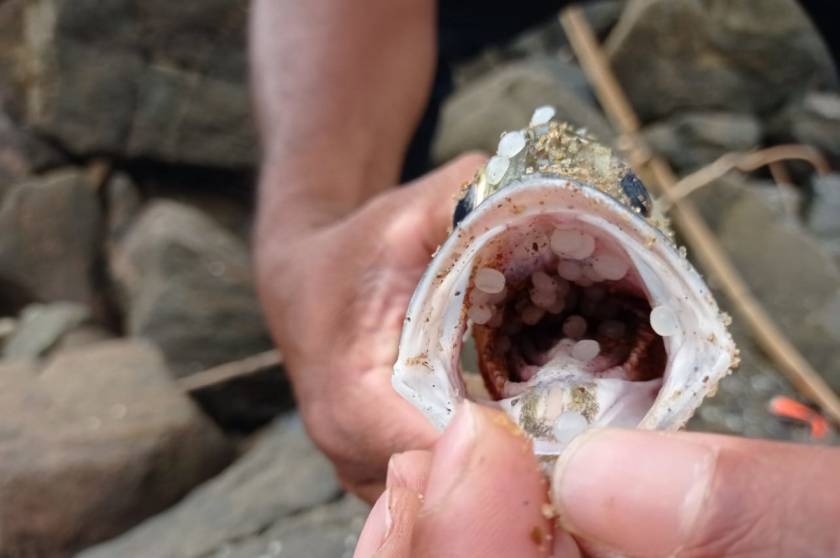 Local fishermen found the plastic granules in the gills and guts of fish, although researchers are still trying to determine whether the plastic is responsible for the death of the fish. Photo: Sri Lanka Marine Environment Protection Authority
Local fishermen found the plastic granules in the gills and guts of fish, although researchers are still trying to determine whether the plastic is responsible for the death of the fish. Photo: Sri Lanka Marine Environment Protection Authority
Worse still, many of the pellets were charred, causing them to crumble into a potentially toxic powder when set in motion.
"It wasn't just virgin pellets ," Partow said. “About half were burned, so the public is unaware of their toxicity. »
Immediately following the sinking of the X-Press Pearl, hundreds of members of the Sri Lankan Navy, Air Force and Coast Guard were deployed in a massive clean-up operation overseen by the Marine Environment Protection Authority. Working day and night under strict COVID-19 lockdown restrictions, they have so far collected more than 53,000 bags of pellets, burnt plastic and other debris mixed with sand. The small size of the plastic pellets meant that many had to be sifted by hand.
There is no way, however, to clean up the plastic pellets still in the ocean.
"What's in the sea could be there for a long time," Thummarukudyil said.
A toxic infusion
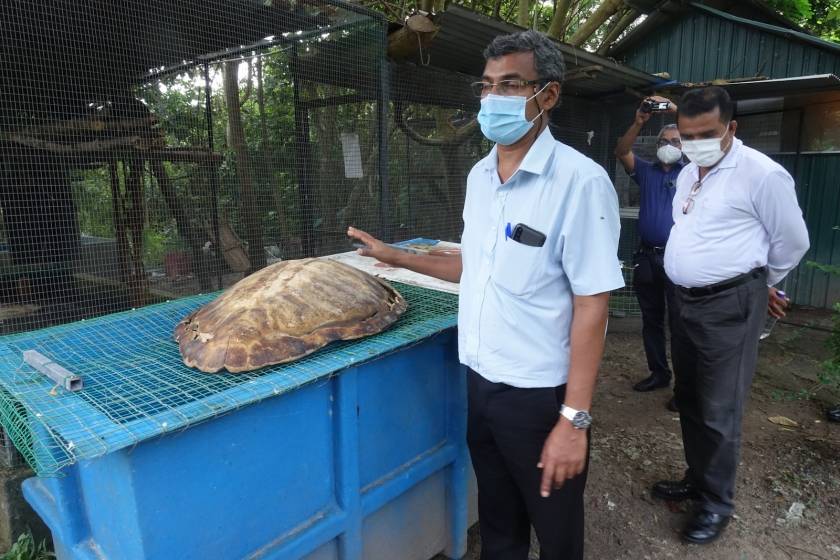 Experts fear that the Pearl X-Press chemicals did scalded marine life. Sri Lankan authorities have found turtle carcasses with what they suspect are burn marks, although searches are ongoing. Photo: UNEP
Experts fear that the Pearl X-Press chemicals did scalded marine life. Sri Lankan authorities have found turtle carcasses with what they suspect are burn marks, although searches are ongoing. Photo: UNEP
It also seems likely that at least part of the highly corrosive nitric acid in the X-Press Pearl is either infiltrated into the ocean. Experts fear it scalded marine life in a nearby coral reef.
June 22, Wild Life Department data showed 107 dead turtles, of which 57 were Olive Ridley species, 19 were green turtles, 02 hawksbill, one leatherback turtle and others were unidentified at the time. At least three eels were also washed ashore. On July 7, the Sri Lankan government confirmed that 176 turtles, four whales and 20 dolphins had died and washed up on Sri Lankan beaches. The cause of death cannot be attributed with certainty to the X-Press Pearl accident alone, however, such a high number of fatalities is unprecedented, even during the monsoon season.
While the nitric acid has likely dissipated into the ocean, concern has now turned to another toxic chemical carried by the X-Press bead: epoxy resin. About 9,800 metric tons of epoxy were on board and experts fear that if it was in toxic liquid form – as opposed to solid form – it could spread along the Sri Lankan coast.
The vessel also contained a cocktail of other chemicals, including methanol, gear oil, brake fluid and urea, as well as lead, copper and lithium batteries, according to Withanage .
The question of oil
The exact amount of toxic material that remains in the ship's hold or in containers in the bottom of the ocean remains unknown. Sri Lanka's annual monsoon, coupled with a nationwide COVID-19 lockdown, hampered rescue efforts.
The ship's owner, X-Press Feeders, said much of the cargo could have been burned in the fire, including the black molasses-like fuel that powered the X-Press Pearl. But the UN team thinks that even if the oil was burned, it is unlikely to have evaporated. Instead, it would likely turn into a more viscous mixture.
"We should assume the oil is still there," Thummarukudyil said. The ship, he added, was carrying enough oil to cover the entire west coast of Sri Lanka. “The potential is there for it to be much worse than what we have already seen. »
Disaster Response
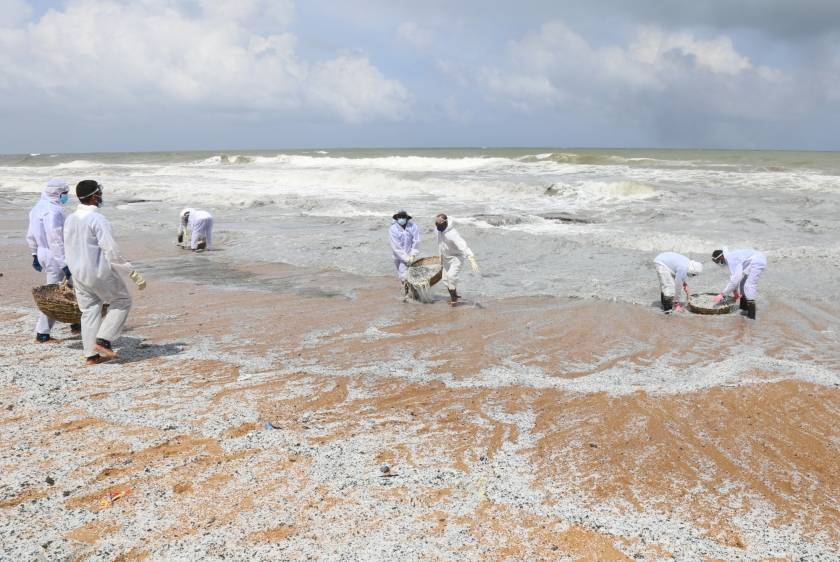 The small size of plastic granules means that some must be collected and sifted by hand a laborious process. Sri Lanka has so far filled 53,000 garbage bags with pellets, sand and other debris. Photo: Sri Lanka Marine Environment Protection Authority
The small size of plastic granules means that some must be collected and sifted by hand a laborious process. Sri Lanka has so far filled 53,000 garbage bags with pellets, sand and other debris. Photo: Sri Lanka Marine Environment Protection Authority
UNEP staff working on the sinking of the X-Press is part of a Pearl if intervention unit catastrophe managed jointly by the Office for the Coordination of UN Humanitarian Affairs (OCHA). The unit helped broker an agreement between the Sri Lankan government and the owner of the X-Press Pearl to contain a possible oil spill at sea and clean up the shore. Specialized equipment, including inflatable booms designed to trap oil, arrived in Colombo on July 2.
"The UN help the government of Sri Lanka to deal with the disaster of Pearl MV X-Press," said the Resident Coordinator of the United Nations in Sri Lanka, Hanaa Singer-Hamdy. “We are coordinating international efforts and mobilizing our partners to ensure a coherent and effective response to the crisis (and) ensure the prevention of such disasters in the future. »
UNEP called on the ship's owner and insurer to develop what Partow called a "peer-reviewed and government-approved" roadmap for removing the X-Press Pearl and stray containers from the seabed , saying they pose the most immediate risk of pollution.
"This plan needs to be developed now so that when conditions permit, the vessel can be retired and properly decommissioned," Partow said.
A team of 40 experts and scientists in the field, co-chaired by Professor Ajith de Alwis, Dean of the Faculty of Graduate Studies at Moratuwa University and Professor Prshanthi Gunawardena from the Department of Forestry and Environmental Sciences of the University of Sri Jayewardenepura, was commissioned to estimate the environmental damage.
Assistance was provided by 14 government agencies, including the Department of Government Analyst, the Central Environment Authority and the Department of Wildlife Conservation. In addition, laboratory assistance has been obtained from foreign countries, including the United Kingdom, Australia and France.
When it comes to the environment, every plastic nurdle is a disaster.
Hemantha Withanage, Center for Environmental Justice
Time is running out for Withanage. "It's a fair deal for them," he said of the salvage company hired to salvage the ship as well as the ship's owner. “But for us, it's our environment. As long as the ship is there, the contamination is there. »
UNEP will submit a final report on the disaster to the Sri Lankan government next week. It will contain recommendations for cleanup and suggestions on how Sri Lanka, a country vying to become a major shipping hub, can cope with future maritime disasters. Partow said that UNEP would also take away to advise the Sri Lanka on environmental monitoring in the longer term.
Ghost scene
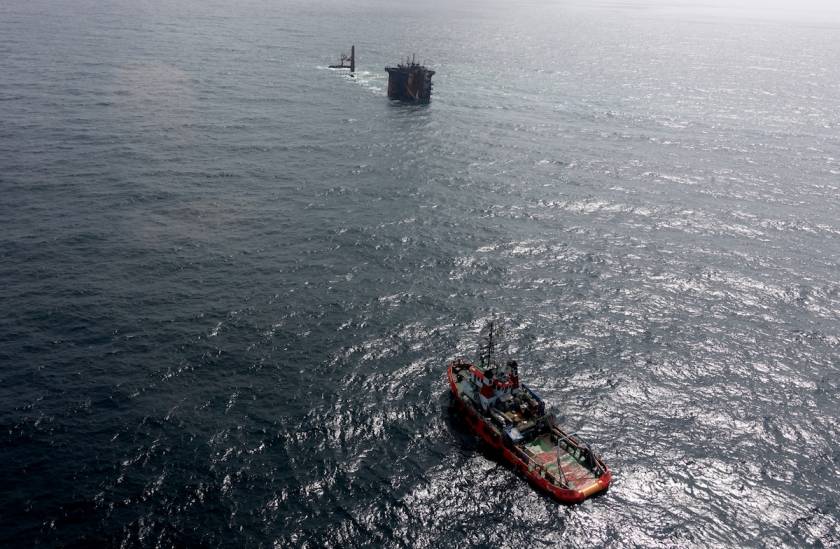 A guard ship toured the X-Press 24 Pearl 24 hours, watching the wreck in search of an oil spill. The Pearl X-Press, ravaged by a fire that lasted for weeks, sits in 21 meters of water. UNEP and the Sri Lankan government are pushing the shipowner to refloat and tow the vessel. Photo: UNEP
A guard ship toured the X-Press 24 Pearl 24 hours, watching the wreck in search of an oil spill. The Pearl X-Press, ravaged by a fire that lasted for weeks, sits in 21 meters of water. UNEP and the Sri Lankan government are pushing the shipowner to refloat and tow the vessel. Photo: UNEP
Today, the ship is largely submerged in 21 meters of water, the high end and some charred cranes remain above the waves. A guard ship surrounds it 24 hours a day, monitoring the oil leak.
Partow, who visited the wreckage by boat and helicopter, saw plastic pellets mixed with oil floating in the waves around the ship. Brown smudges of oil surrounded by a gray sheen stretched two to three kilometers into the sea.
RELATED
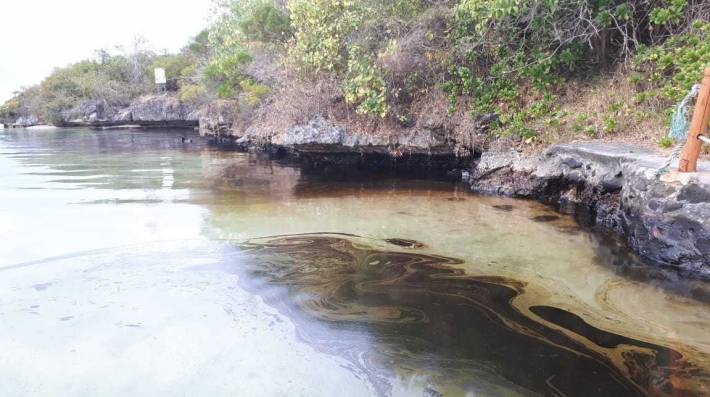
HISTORY
Mauritius oil spill calls for more efforts to safeguard coral reef ecosystems
He described the 186-meter-long vessel, which entered service in February, as "a write-off ."
Thummarukudyil has spent 18 years responding to oil spills around the world. When asked if the X-Press Pearl was the worst maritime environmental disaster he had seen, he paused.
“There are still a lot of chemicals out there,” he said. “This story is not over yet. »
Posted on 2022-01-22 12:02








Comments